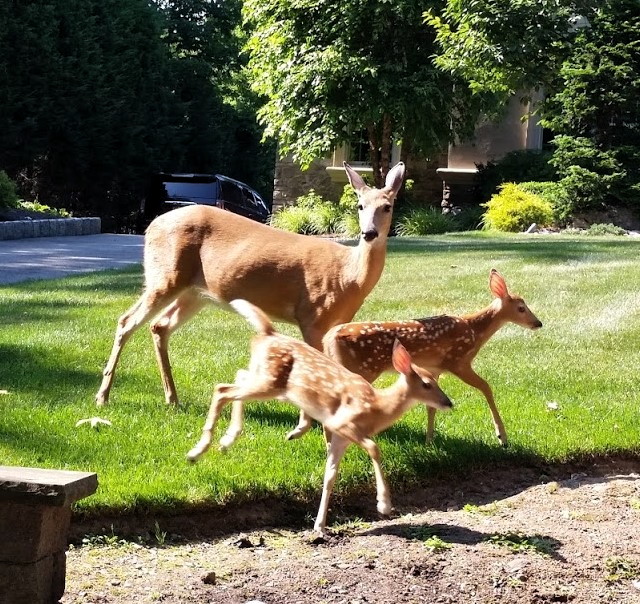EDISON – Scientifically, ovariectomies – the removal of ovaries – has proven effective in culling the deer population, according to Doreen Frega, outreach director of the Animal Protection League of New Jersey.
Frega offered her recommendations at an Edison Township Council meeting on Oct. 21 as officials continue to decide what is the best and most practical solution in solving the problems of the growing deer – specifically white tail deer – population in the township.
Over the past year, residents have raised concerns, from deer eating homeowner’s plants and leaving droppings on lawns, to deer causing motor vehicle accidents and carrying Lyme disease.
“I moved into my house 35 years ago and I didn’t see a deer until maybe five to six years ago,” Councilman Robert Diehl said. “Now I see small groups of deer every single day.”
In April 2018, Anthony DeNicola, of White Buffalo Inc., a Connecticut-based deer management company, made a presentation on various options before the Township Council.
The options included having archers from an archery recreational program come in certain times of the year and hunt for deer in an open park; hiring professional hunters to shoot and kill the deer; tranquilizing and killing the deer; and/or tranquilizing and transporting deer to a medical facility for sterilization.
Diehl said there have been no good answers because of the makeup of Edison of industry, school properties and many residential roads.
Frega said with the ovariectomy process, bait would be placed in the area – usually a large piece of land such as a park – and then the deer would be able to be darted and a volunteer veterinarian would come on site to conduct the ovariectomy in a mobile clinic.
“Scientifically [ovariectomies] have been very effective, but in New Jersey politically, it’s very difficult because of the NJDEP [New Jersey Department of Environmental Protection] Division of Fish and Wildlife and their reluctance to give out these permits [for surgical sterilizations],” she said.
To obtain a permit for community-based deer management, a municipality must explain why traditional deer control methods, i.e. hunting, have not been working, she said.
Frega said the main cause of the death of adult deer is hunting; however, the practice does not reduce the population due to policies of the DEP Division of Fish and Wildlife and the gaming industry with farm leases and the allowance of clearcutting forests for hunters in their efforts to increase the doe’s fertility rates.
Deer have been targeted by game agencies as the number one hunted animal, Frega said, reporting that 20 years ago there were twice as many deer in New Jersey, now there about 100,000 deer. In the 2018-19 hunting season, hunters killed 50,861 deer in New Jersey, she said.
Along with an ovariectomy, Frega said there are a number of nonlethal conflict management practices that could be implemented from wrapping white fabric on signs, which researchers in Wyoming discovered deer’s mistake the white fabric as a white tail signifying danger to a sounding a hornet sonic device.
For yards, deer resistant plants, Irish Spring soap, invisible clear wire fence, and noise could be implemented for deer deterrence, as well as clearing brush, litter and acorns, mowing the grass short, removing birdfeeders, bird baths and salt licks, and moving shrubbery away from one’s home.
Frega said it is important not to feed the deer, which is the very first step in conflict management to stop the practices that contribute to increasing deer fertility.
She also explained that deer often are held responsible for Lyme disease, which can be also carried by mice and coyotes. She added opossums are a great source to rely on since they can eat 5,000 ticks a day.
In fall 2018, the township conducted a deer count with Dan Bernier, director of parks, planning and environmental services for Union County Parks.
Bernier said New Jersey is the most densely populated state in the nation. With Edison as one of the more highly developed areas in the state, white tail deer have not been staying in forested areas, he said.
In the vicinity of the Metuchen Golf and Country Club, some 70 deer were observed in an estimated 482 acres. Bernier said the number increased to an estimated 88 to account for the unforeseen deer.
A healthy forest should have no more than 20 deer per square mile.
The estimated density of the Metuchen Golf and Country Club is 117 deer per square mile.
Near the New Dover Road area, five deer were observed in a 57-acre area with the estimate of three unforeseen deer. In and around the Edison High School area, some 25 deer were counted in an 861-acre area, with six unforeseen deer.
Council President Alvaro Gomez said Frega’s presentation was “exceptionally helpful and educational” and adds to the township’s discussion on figuring out what would be the best solution for the township.

